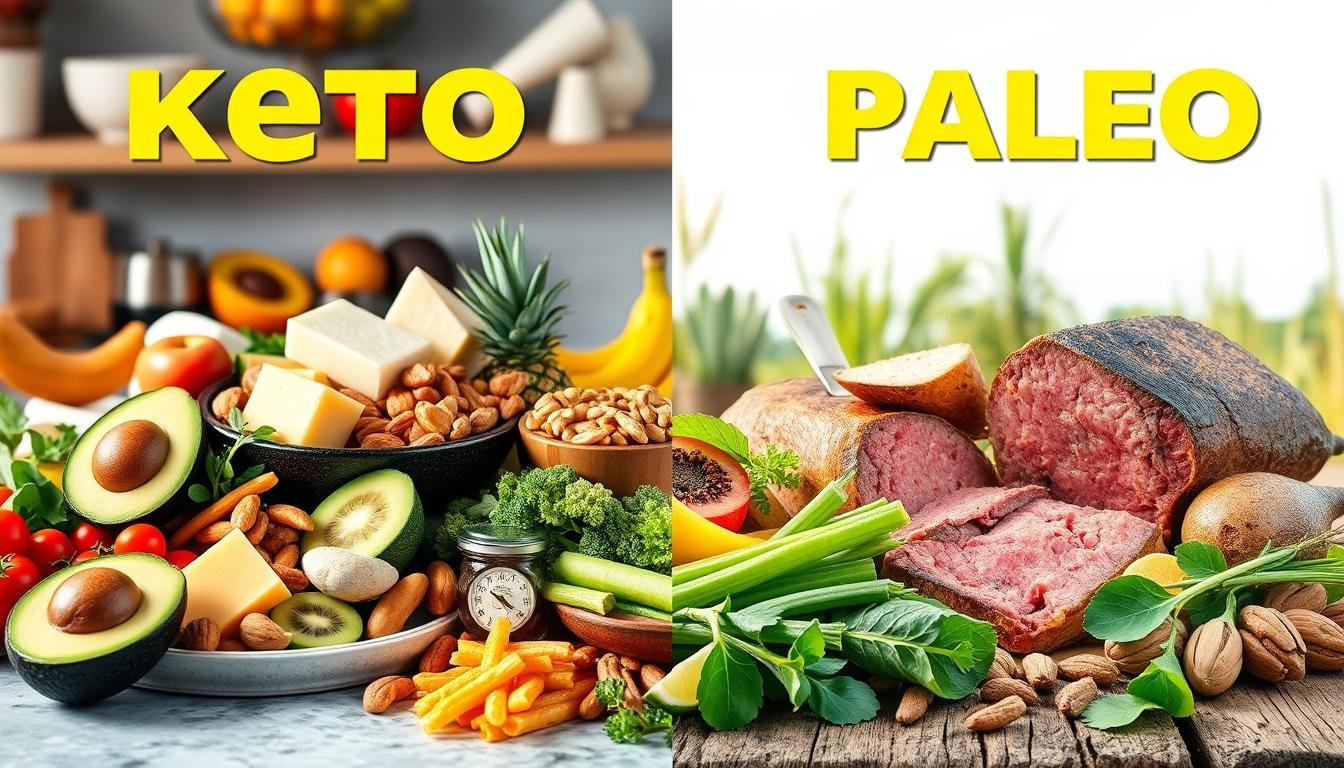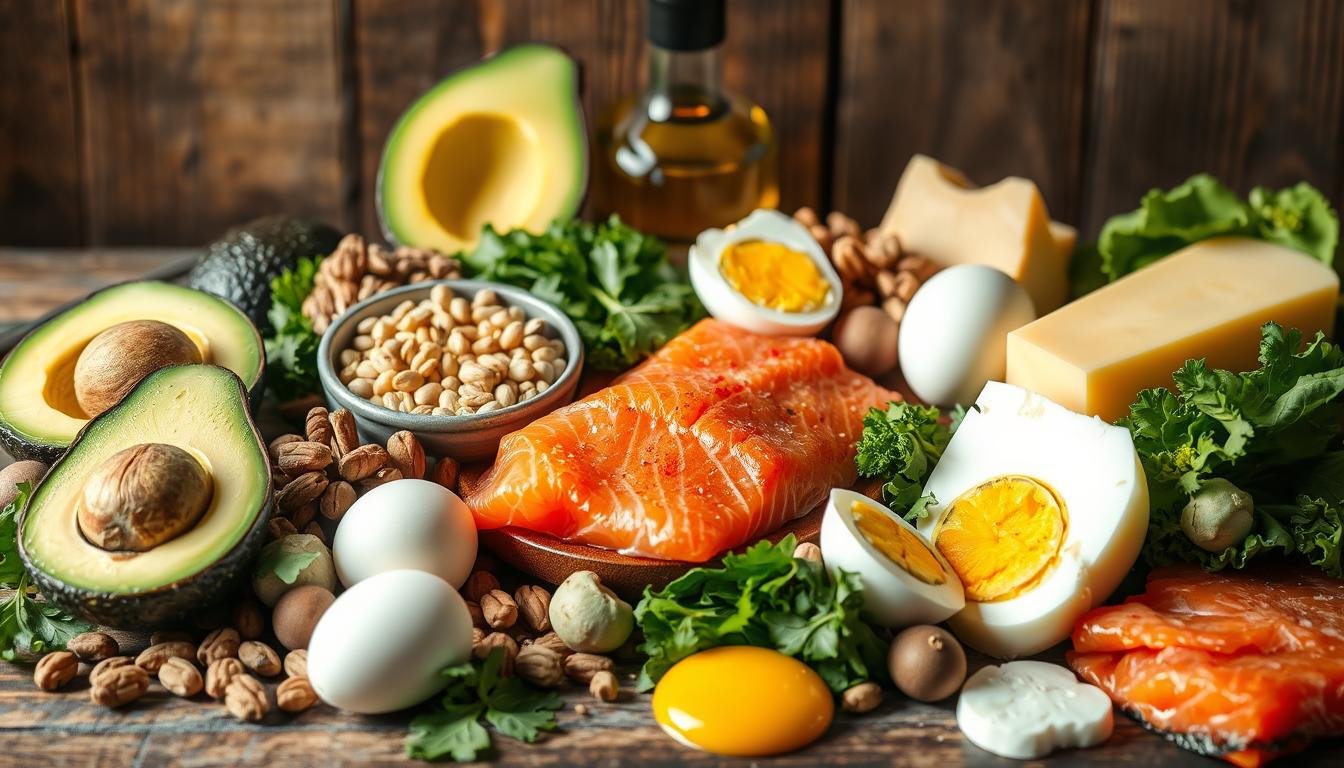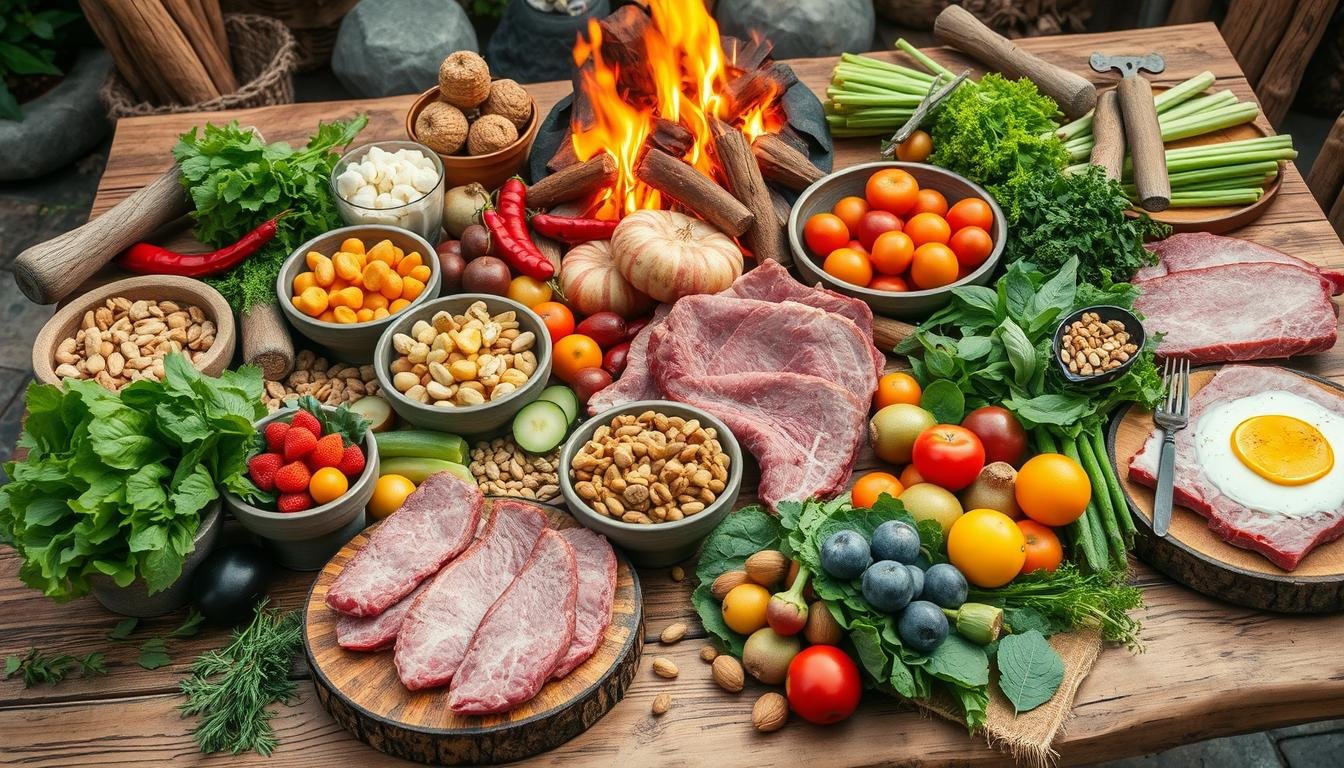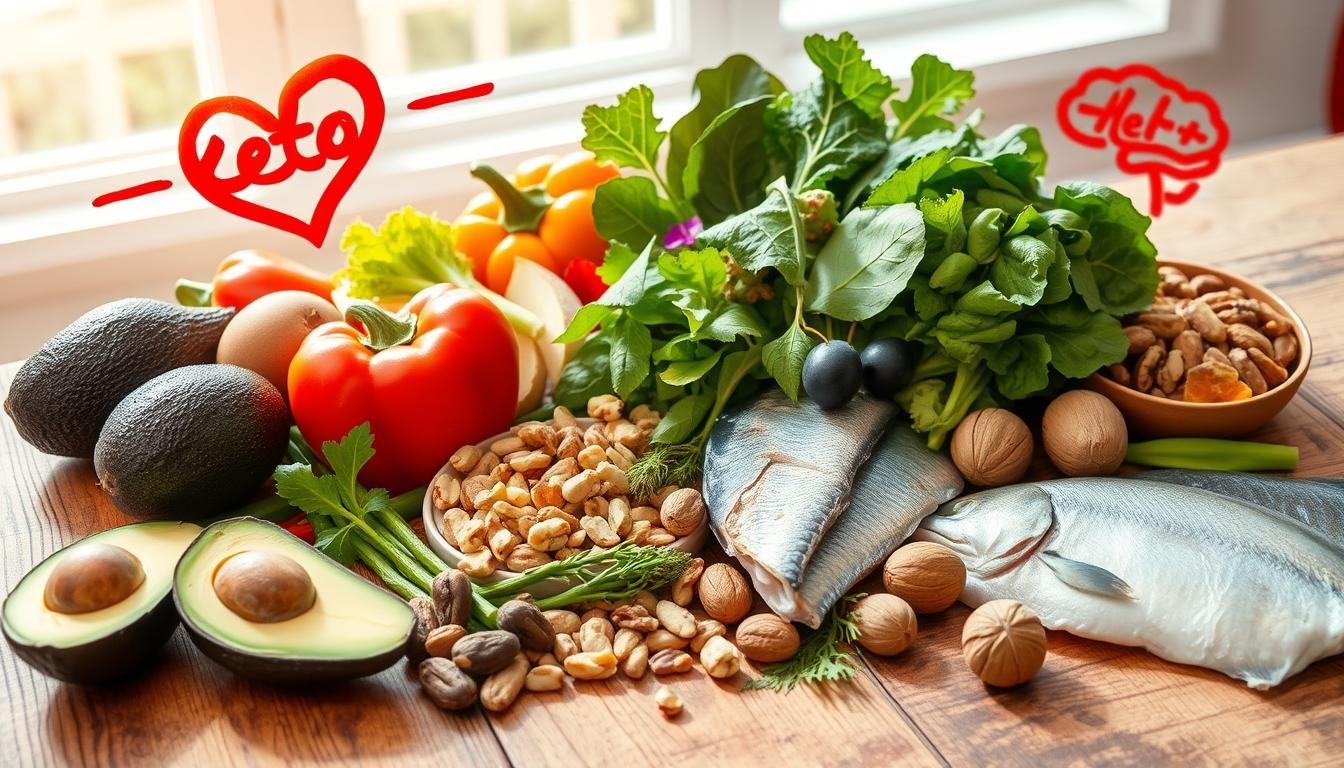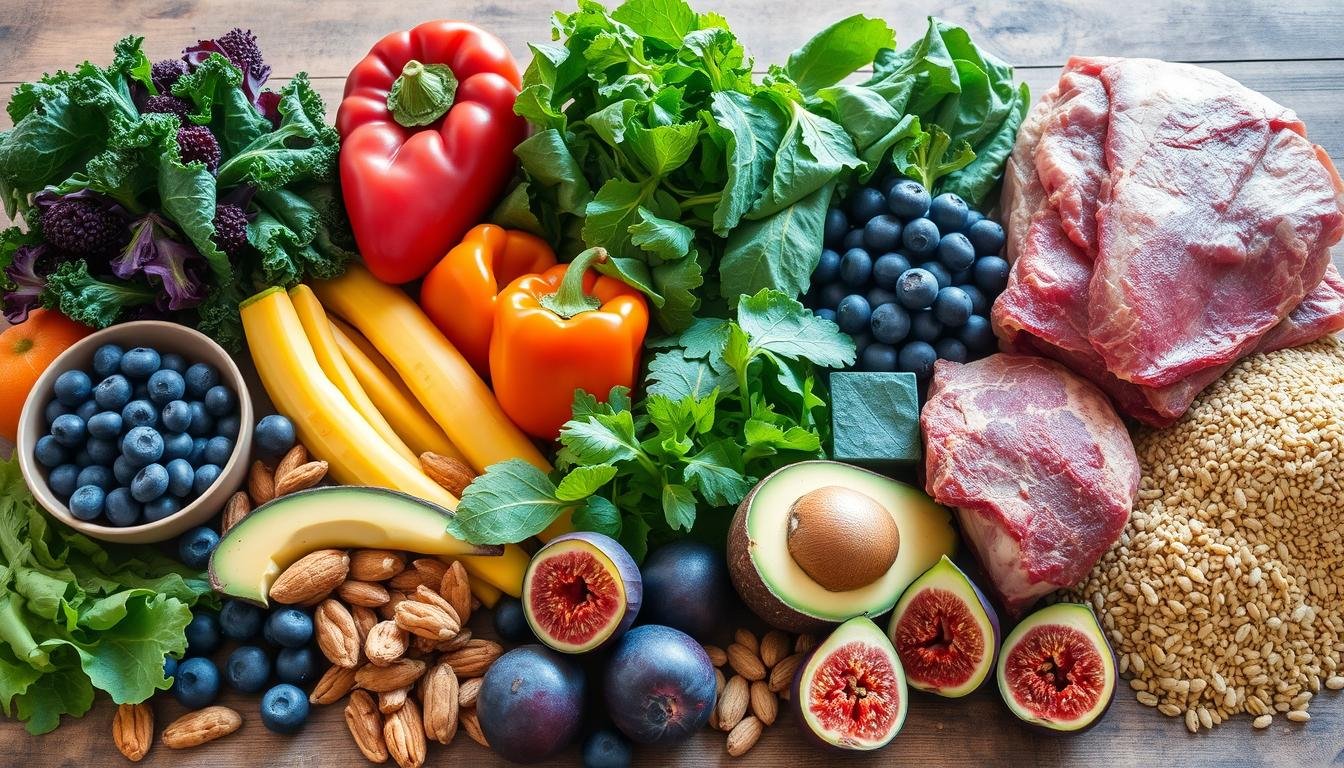Ever thought about whether the keto diet or paleo diet could be the key to your health goals? Finding the right diet can be tough, with many opinions out there. This article will explore the differences between these diets to help you choose wisely.
Whether you want to lose weight, boost energy, or feel better overall, knowing the keto vs paleo debate is key. It helps you find the diet that suits your needs and preferences.
Ready to find out which diet is best for you? Let’s start this nutritional journey together!
Introduction to Keto and Paleo Diets
Two diets often get a lot of attention: the Keto dietary plan and the Paleo lifestyle. Both aim to improve health in different ways. They focus on what foods to eat and what to avoid.
What is the Keto Diet?
The Keto dietary plan is all about eating a lot of fat and not much carb. It makes your body use fat for energy instead of carbs. This helps with weight loss and better health by cutting down carbs and upping fat.
What is the Paleo Diet?
The Paleo lifestyle is based on eating like our ancient ancestors. It’s all about whole foods like lean proteins, fruits, veggies, nuts, and seeds. It avoids processed foods, grains, and dairy. The goal is to eat natural foods for better health.
| Criteria | Keto Diet | Paleo Diet |
|---|---|---|
| Macronutrient Focus | Low-carb high-fat | Lean proteins |
| Primary Goal | Achieve Ketosis | Emulate Paleolithic eating |
| Allowed Foods | Fats, meat, fish, eggs | Meat, fish, fruits, vegetables |
| Restricted Foods | Grains, sugar, most fruits | Processed foods, grains, dairy |
History and Origin of Keto and Paleo Diets
The historical diet origins of keto and paleo diets come from different times and reasons. Knowing where they started helps us see why they’re popular today.
Keto Diet: The keto diet began in the 1920s. It was first used to help people with epilepsy. Doctors found that eating a lot of fat and little carbs could cut down seizures.
This early research led to more studies on ketosis. Now, the keto diet is known for helping people lose weight and improve their health. It makes the body burn fat for energy instead of carbs.
Paleo Diet: The paleo diet looks back to our ancient ancestors for inspiration. It’s also called the caveman diet. It aims to bring back the eating habits of early humans.
By focusing on foods that our Paleolithic ancestors ate, the paleo diet hopes to improve health. Its popularity in the late 20th century shows people want to eat more natural foods.
| Diet | Origin | Main Goal |
|---|---|---|
| Keto Diet | 1920s, as a treatment for epilepsy | Inducing ketosis for health optimization and weight loss |
| Paleo Diet | Late 20th century, inspired by Paleolithic eating patterns | Emulating evolutionary eating patterns for optimal health |
Learning about these historical diet origins shows how they’ve changed over time. It also shows why they’re still important in our diets today.
Keto Diet: Principles and Guidelines
The ketogenic diet focuses on specific guidelines for macronutrients. This helps you achieve ketosis effectively. By following these principles, your body can smoothly enter a fat-burning state.
Macronutrient Breakdown
The keto diet emphasizes a certain macronutrient balance. You should aim for about 70% fats, 25% protein, and 5% carbs. This balance helps your body use fat for energy instead of carbs.
Getting the right balance is key. It prevents fatigue and ensures you get all the nutrients you need.
Allowed Foods on Keto
Choose high-fat, moderate-protein, and low-carb foods for keto. Here are some good options:
- Meats (beef, pork, chicken)
- Fatty fish (salmon, trout, mackerel)
- Cheese (cheddar, mozzarella, brie)
- Nuts and seeds (almonds, walnuts, chia seeds)
- Low-carb vegetables (spinach, kale, avocado)
Also, use high-quality fats like olive oil, coconut oil, and butter. They are important for following keto guidelines.
Foods to Avoid on Keto
To keep carbs low, avoid certain foods. Here’s what to skip:
- Grains (wheat, rice, oats)
- Sugary foods (cakes, cookies, candies)
- Most fruits (bananas, apples, oranges)
- Tubers (potatoes, sweet potatoes)
- Legumes (beans, lentils, chickpeas)
Knowing which foods to avoid helps you stay on track. This ensures you get the best results from the keto diet.
Paleo Diet: Principles and Guidelines
The Paleo diet takes you back to eating like our ancestors. It focuses on whole, unprocessed foods. This way, you eat what nature meant for us to eat.
Macronutrient Breakdown
The Paleo diet doesn’t focus on specific food ratios. It’s all about eating high-quality, whole foods. You’ll get a mix of proteins, fats, and carbs from these foods naturally. This makes it easy to fit the diet to your needs.
Allowed Foods on Paleo
You can enjoy many unprocessed foods on the Paleo diet. These foods are full of nutrients and antioxidants. Some key foods include:
- Meats (grass-fed, pasture-raised options are preferable)
- Fish and seafood
- Fresh fruits
- Vegetables
- Nuts and seeds
- Eggs
- Oils from fruits and nuts like olive oil and coconut oil
These foods give you all the vitamins, minerals, and fatty acids you need for good health.
Foods to Avoid on Paleo
To follow the Paleo diet, you must avoid certain foods. These are foods our ancestors didn’t eat. So, you should not eat:
- Dairy products
- Grains (such as wheat, oats, and barley)
- Legumes (including beans, lentils, and peanuts)
- Processed sugars
- Refined oils
By avoiding these foods, the Paleo diet helps reduce inflammation and improve digestion. It encourages eating natural, unprocessed foods.
Health Benefits of the Keto Diet
The keto diet is known for its many health benefits. One big reason people choose it is for weight loss. By eating fewer carbs and more healthy fats, your body starts burning fat for energy. This leads to losing a lot of weight.
Another great thing about the keto diet is how it helps control blood sugar. Eating fewer carbs means less insulin and more stable blood sugar. This is good for people with type 2 diabetes or anyone wanting better blood sugar control.
The keto diet also has benefits for the brain. Research shows it might help with conditions like epilepsy, Alzheimer’s, and Parkinson’s. The diet gives the brain a different fuel, which could make it work better and protect it.
Heart health also gets a boost from the keto diet. It can raise HDL cholesterol, the “good” kind. Foods like avocados, nuts, and olive oil are full of healthy fats. These fats are good for your heart.
If you’re looking for a diet that improves your health in many ways, the keto diet is a strong choice. It helps with weight loss, blood sugar control, and overall health. It’s no surprise the keto diet is becoming more popular among health-conscious people.
Health Benefits of the Paleo Diet
The paleo diet is known for its focus on nutrient-dense foods and health benefits. It emphasizes whole foods and avoids processed items. This leads to better digestion and more energy.
Improved Digestion
The paleo diet is great for your digestive health. It removes gluten and dairy, which can cause bloating. The diet is full of fiber from veggies and fruits, helping your gut stay healthy.
Increased Energy Levels
The paleo diet also boosts your energy. It uses proteins, fats, and carbs from whole foods for energy. This balance keeps your blood sugar steady, giving you energy all day long.
| Aspect | Impact |
|---|---|
| Nutrient Density | High |
| Digestive Health | Improved |
| Energy Levels | Sustained |
| Blood Sugar Regulation | Stable |
Keto vs Paleo: Which Diet is Right for You?
Choosing between keto and paleo diets means looking at what fits your lifestyle best. Each diet has its own benefits. You need to think about your health goals and daily habits.
The keto diet is all about eating lots of fat and little carbs. It’s great for weight loss or managing health issues like epilepsy or type 2 diabetes. The paleo diet, on the other hand, focuses on eating natural, unprocessed foods like our ancestors did. It’s good for those who want to improve their overall health and reduce inflammation.
When you compare keto vs paleo, consider how flexible each diet is. Keto requires careful tracking of what you eat to stay in ketosis. Paleo, however, is more flexible, allowing a wide range of natural foods but avoiding processed ones.
Here’s a table to help you see the main differences between keto and paleo diets:
| Aspect | Keto | Paleo |
|---|---|---|
| Primary Focus | High-fat, low-carb | Whole, unprocessed foods |
| Carbohydrate Intake | Very low | Moderate |
| Allowed Foods | Meats, fish, dairy, oils | Meats, fish, vegetables, nuts, seeds |
| Foods to Avoid | Sugar, grains, starchy vegetables | Dairy, legumes, refined sugar |
| Suitability | Weight loss, diabetes management | Overall wellness, anti-inflammatory |
Think about how each diet fits your personal needs. If you have dietary restrictions or health conditions, choose the diet that matches your needs better. Your goals and preferences will help you decide between keto and paleo, ensuring you pick the best diet for you.
Challenges and Drawbacks of the Keto Diet
The ketogenic diet has become popular for its health benefits. But, it’s key to know the challenges and drawbacks. Starting a keto lifestyle comes with hurdles you should be aware of.
Common Challenges
One of the first hurdles is the keto flu. This adjustment period can bring headaches, fatigue, and irritability. Your body is learning to burn fat instead of carbs. Also, following ketogenic diet restrictions can be hard. It means cutting out fruits, grains, and some veggies, which can cause nutrient deficiencies.
Possible Health Risks
Long-term keto diet use can lead to health risks. Kidney stones might develop due to high protein intake. Liver problems could also occur, especially if you already have liver issues. Furthermore, keto diets can increase cholesterol levels, which is a heart health concern.
| Challenge | Description |
|---|---|
| Keto Flu | Symptoms such as headaches and fatigue during the adaptation phase. |
| Nutrient Deficiencies | Potential lack of vital nutrients due to restrictive food intake. |
| Kidney Stones | Increased risk due to high protein consumption. |
| Liver Issues | Potential complications, especially for those with existing liver conditions. |
| Increased Cholesterol | Potential for heightened cholesterol levels, impacting heart health. |
Challenges and Drawbacks of the Paleo Diet
The Paleo diet is popular for focusing on whole foods. Yet, it comes with its own set of challenges. One major issue is the paleo diet limitations on food variety. By cutting out grains, dairy, and legumes, it can feel too narrow. This might lead to missing out on important nutrients if not balanced right.
There are also sustainability concerns with the Paleo diet. Its heavy focus on animal protein can harm the environment. This is because it leads to more meat being eaten. It makes you wonder if the diet is good for our planet in the long run.
Another problem is the cost of following a Paleo diet. Buying organic foods, grass-fed meats, and other special items can be expensive. For many, this makes the diet hard to afford. It limits who can try it, especially those on a tight budget.
It’s important to think about these challenges before deciding on the Paleo diet. Weighing its health benefits against its practical downsides can help you make a better choice.
Conclusion
As you finish this guide, it’s clear that keto and paleo diets have their own rules and benefits. You might prefer the keto diet’s high-fat, low-carb approach or the paleo diet’s focus on whole foods. Either way, making smart food choices is crucial.
Personalized nutrition is key. What works for one person might not work for another. It’s important to choose a diet that fits your health goals and daily life. Knowing the benefits of keto and paleo helps you make a choice that supports your health.
Choosing a diet should be about finding a healthy path, not just following trends. You might choose keto, paleo, or a mix of both. Remember, staying committed and consistent is essential. Now, you’re ready to start your journey to better health with confidence.

